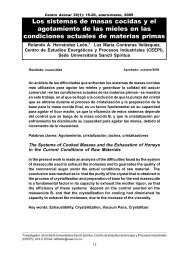guía mip del cultivo de la yuca - Centro@Ciencia,Biblioteca Digital ...
guía mip del cultivo de la yuca - Centro@Ciencia,Biblioteca Digital ...
guía mip del cultivo de la yuca - Centro@Ciencia,Biblioteca Digital ...
Create successful ePaper yourself
Turn your PDF publications into a flip-book with our unique Google optimized e-Paper software.
Nicaragua está iniciando proyectos <strong>de</strong> <strong>de</strong>sarrollo<br />
con el objetivo <strong>de</strong> mejorar <strong>la</strong> tecnología<br />
<strong>de</strong> producción y aumentar los rendimientos<br />
<strong>de</strong> productos exportables. En este sentido, el<br />
INTA ha dado los primeros pasos a partir <strong><strong>de</strong>l</strong><br />
año 2003 con <strong>la</strong> introducción y establecimiento<br />
<strong>de</strong> bancos <strong>de</strong> germop<strong>la</strong>sma <strong><strong>de</strong>l</strong> <strong>cultivo</strong><br />
<strong>de</strong> <strong>la</strong> <strong>yuca</strong> en <strong>la</strong>s zonas <strong>de</strong> Nueva Guinea,<br />
Masaya y León, con el fin <strong>de</strong> i<strong>de</strong>ntificar y ampliar<br />
<strong>la</strong> diversidad genética existente y caracterizar<br />
<strong>la</strong>s varieda<strong>de</strong>s <strong>de</strong> mejor potencial,<br />
con el objetivo <strong>de</strong> dar respuestas a <strong>la</strong>s limitantes<br />
que presentan los productores <strong>de</strong> este<br />
II. ¿CUÁL ES EL ORIGEN DE LA YUCA?<br />
La <strong>yuca</strong>, es una p<strong>la</strong>nta originaria <strong>de</strong> América<br />
<strong><strong>de</strong>l</strong> Sur y fue domesticada hace unos 5000<br />
años y cultivada extensivamente, <strong>de</strong>s<strong>de</strong> entonces,<br />
en zonas tropicales y subtropicales<br />
<strong><strong>de</strong>l</strong> continente. No existe un registro documentado<br />
sobre <strong>la</strong> presencia <strong>de</strong> pob<strong>la</strong>ciones<br />
silvestres <strong>de</strong> <strong>la</strong> p<strong>la</strong>nta antes <strong>de</strong> esa fecha.<br />
M a n e j o I n t e g r a d o d e P l a g a s<br />
rubro, haciendo énfasis en los materiales<br />
tolerantes a <strong>la</strong>s diferentes p<strong>la</strong>gas.<br />
Para <strong>la</strong> e<strong>la</strong>boración <strong>de</strong> <strong>la</strong> presente Guía Técnica<br />
en Manejo Integrado <strong>de</strong> P<strong>la</strong>gas <strong>de</strong> <strong>la</strong><br />
Yuca, se consi<strong>de</strong>raron el Listado Oficial <strong>de</strong><br />
P<strong>la</strong>gas reportadas en Nicaragua (Dirección<br />
<strong>de</strong> Sanidad Vegetal/MAG-FOR, 2001), y los<br />
trabajos <strong>de</strong> investigación realizados en los<br />
Centros Experimentales <strong><strong>de</strong>l</strong> Instituto Nicaragüense<br />
<strong>de</strong> Tecnología Agropecuaria (INTA) y<br />
el Centro Internacional <strong>de</strong> Agricultura Tropical<br />
(CIAT), ubicado en Colombia.<br />
Dos factores influyeron en <strong>la</strong> domesticación<br />
<strong>de</strong> Manihot esculenta Crantz: <strong>la</strong> necesidad<br />
<strong>de</strong> inventar métodos para eliminar los principios<br />
venenosos <strong>de</strong> <strong>la</strong>s raíces, <strong>de</strong>bido al<br />
ácido cianhídrico (HCN), y a <strong>la</strong> propagación<br />
vegetativa, que permitió el <strong>cultivo</strong> fácil, seguro<br />
y con una dispersión rápida.<br />
CUADRO 1. Contenido <strong>de</strong> HCN (ácido cianhídrico) en diferentes órganos <strong>de</strong> <strong>la</strong> p<strong>la</strong>nta <strong>de</strong> <strong>yuca</strong><br />
(mg/kg <strong>de</strong> materia fresca).<br />
PARTES DE LA PLANTA<br />
Hojas adultas<br />
Tallos ver<strong>de</strong>s<br />
Tallo leñoso, adulto<br />
Médu<strong>la</strong> <strong><strong>de</strong>l</strong> tallo<br />
Raíz<br />
VARIEDADES<br />
DULCES AMARGAS<br />
16<br />
14<br />
43<br />
19<br />
4<br />
Fuente: Empresa Brasileña <strong>de</strong> Asistencia Técnica y Extensión Rural, 1979.<br />
41<br />
24<br />
113<br />
26<br />
53<br />
GUÍA MIP DEL CULTIVO DE LA YUCA<br />
5



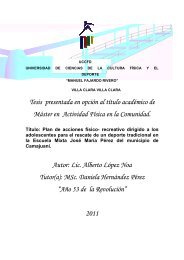

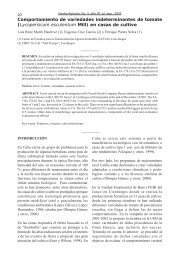
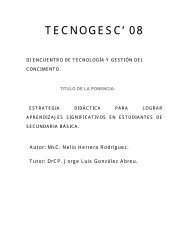
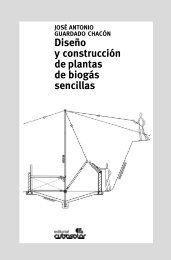
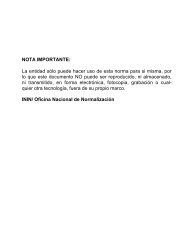
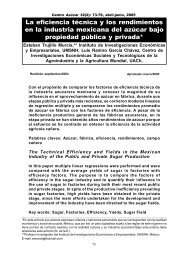
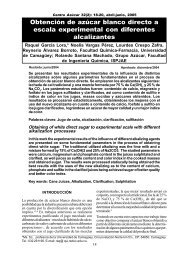



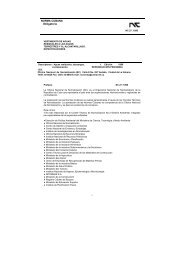
![MCApella.ppt [Sólo lectura] - Centro@Ciencia,Biblioteca Digital de ...](https://img.yumpu.com/17096857/1/190x143/mcapellappt-solo-lectura-centrocienciabiblioteca-digital-de-.jpg?quality=85)
